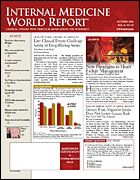Publication
Article
Internal Medicine World Report
7-Day Continuous Monitoring Improves Glycemic Control
Author(s):
From the American Association of Diabetes Educators
Los Angeles—Use of a transcutaneous 7-day continuous blood glucose monitor led to significant improvements in the glycemic profile of both poorly controlled and well-controlled patients with diabetes, according to data reported at the American Association of Diabetes Educators annual meeting.
After a 3-week trial of the STS Continuous Glucose Monitoring System, a continuous glucose monitor, patients with poor glycemic control had reduced mean glucose levels and improved target-range glycemia, without any increase in hypoglycemic episodes. Well-controlled patients maintained the time spent in the target range for glycemia, but experienced significantly less hypoglycemia.
“As patients start to see the data, they can make more intelligent decisions,” said Howard C. Zisser, MD, director of clinical research at the Sansum Diabetes Research Institute in Santa Barbara, Calif. “By the end of the study, patients were dampening the [blood glucose] highs and dampening the lows.”
The findings are from a study of 86 insulin-requiring patients: 69 with type 1 diabetes and 17 with type 2 diabetes. Of these patients, 12 had poorly controlled diabetes, defined as hemoglobin (Hb) A1c >9%; 26 had good control (HbA1c ≤7%); and the remainder had intermediate glycemic control.
Each patient used the STS monitor for 3 consecutive 7-day monitoring periods. The system includes a glucose sensor that is inserted into the abdomen and measures and reports glucose values every 5 minutes. The device is equipped with a programmable alarm to alert of blood glucose fluctuations.
Dr Zisser noted that the STS monitor is currently approved for 72 hours of use per sensor, and the 7-day sensor is now in clinical studies.
Patients inserted the sensors under the supervision of clinical staff and then used the device at home or at work. The monitor provided information on 1-, 3-, and 9-hour blood glucose trends and was programmed to provide an alert if levels fell to <80 mg/dL and to sound a hypoglycemia alarm if they fell to <55 mg/dL.
During the first monitoring period, patients were blinded to the results. During the second and third periods, they used the monitor as an adjunct to diabetes self-management.
Comparison of the blinded and unblinded monitoring periods revealed significant improvements in glycemic control among all patients, including those with poorly controlled glucose levels (Table).
Patients with good control at baseline had a significant 46.4% decrease in time spent in the hypoglycemic range.
The 4 adverse events reported during the study were not considered serious or device related. No sensor-related infections or hypoglycemic events requiring third-party intervention were reported.
“Sometimes with therapy, you can decrease the highs but also increase the lows,” said Dr Zisser. “As HbA1c gets better, the risk of severe hypoglycemia may increase. Because of the ability to set alarms and identify trend setting, patients can decrease hyperglycemia and decrease hypoglycemia, allowing them to spend more time in the normal range.”






